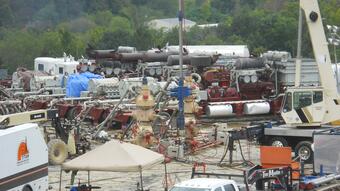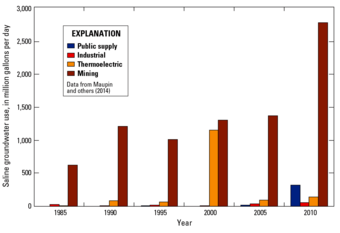National Brackish Groundwater Assessment: How is Brackish Groundwater Being Used?
Industry and public drinking-water suppliers are increasingly turning to brackish groundwater to supplement or replace the use of freshwater. Brackish groundwater is either directly used or treated.
Direct Use
Brackish groundwater is directly used for purposes such as cooling water for power generation, aquaculture, and for a variety of uses in the oil and gas industry such as drilling, enhancing recovery, and hydraulic fracturing.


Treated Use
For purposes requiring lower dissolved-solids content, especially drinking water, brackish water is treated through reverse osmosis or other desalination processes. In 2010, there were 649 active desalination plants in the United States with a capacity to treat 402 million gallons per day (Shea, 2010). Of the desalination plant capacity in the United States, 67 percent was for municipal purposes, 18 percent for industry, 9 percent for power, and the remaining 6 percent for other uses (Mickley, 2010). A total of 314 desalination facilities are used for municipal purposes, 49 percent of which were in Florida, 16 percent in California, 12 percent in Texas, and the remaining 23 percent dispersed among other states. More than 95 percent of the desalination facilities in the United States are inland (Mickley, 2010), and most facilities are designed to treat groundwater with dissolved-solids concentrations in the brackish range (Shea, 2010). Recent advances in technology have reduced the cost and energy requirements of desalination, making treatment of brackish groundwater a more viable option for drinking-water supplies (National Research Council, 2008).

Amount of Saline* Groundwater Being Used
The National Water-Use Science Project, part of the National Water Census, has published information about saline water use since 1985. The reports include estimates of water withdrawals by State, source of water, and category of use. *Saline water for purposes of that program is defined as water with a dissolved-solids concentration greater than 1,000 milligrams per liter and includes the brackish concentration range.


Below are other science projects associated with the National Brackish Groundwater Assessment.
Brackish Groundwater Assessment
About the USGS National Brackish Groundwater Assessment
National Brackish Groundwater Assessment: Sources of Dissolved Solids in Brackish Groundwater
National Brackish Groundwater Assessment: How is Brackish Groundwater Being Used?
National Brackish Groundwater Assessment: Pilot Saline Studies
National Brackish Groundwater Assessment: Previous Work
Below are publications associated with this project.
Estimated use of water in the United States in 2010
Industry and public drinking-water suppliers are increasingly turning to brackish groundwater to supplement or replace the use of freshwater. Brackish groundwater is either directly used or treated.
Direct Use
Brackish groundwater is directly used for purposes such as cooling water for power generation, aquaculture, and for a variety of uses in the oil and gas industry such as drilling, enhancing recovery, and hydraulic fracturing.


Treated Use
For purposes requiring lower dissolved-solids content, especially drinking water, brackish water is treated through reverse osmosis or other desalination processes. In 2010, there were 649 active desalination plants in the United States with a capacity to treat 402 million gallons per day (Shea, 2010). Of the desalination plant capacity in the United States, 67 percent was for municipal purposes, 18 percent for industry, 9 percent for power, and the remaining 6 percent for other uses (Mickley, 2010). A total of 314 desalination facilities are used for municipal purposes, 49 percent of which were in Florida, 16 percent in California, 12 percent in Texas, and the remaining 23 percent dispersed among other states. More than 95 percent of the desalination facilities in the United States are inland (Mickley, 2010), and most facilities are designed to treat groundwater with dissolved-solids concentrations in the brackish range (Shea, 2010). Recent advances in technology have reduced the cost and energy requirements of desalination, making treatment of brackish groundwater a more viable option for drinking-water supplies (National Research Council, 2008).

Amount of Saline* Groundwater Being Used
The National Water-Use Science Project, part of the National Water Census, has published information about saline water use since 1985. The reports include estimates of water withdrawals by State, source of water, and category of use. *Saline water for purposes of that program is defined as water with a dissolved-solids concentration greater than 1,000 milligrams per liter and includes the brackish concentration range.


Below are other science projects associated with the National Brackish Groundwater Assessment.
Brackish Groundwater Assessment
About the USGS National Brackish Groundwater Assessment
National Brackish Groundwater Assessment: Sources of Dissolved Solids in Brackish Groundwater
National Brackish Groundwater Assessment: How is Brackish Groundwater Being Used?
National Brackish Groundwater Assessment: Pilot Saline Studies
National Brackish Groundwater Assessment: Previous Work
Below are publications associated with this project.







